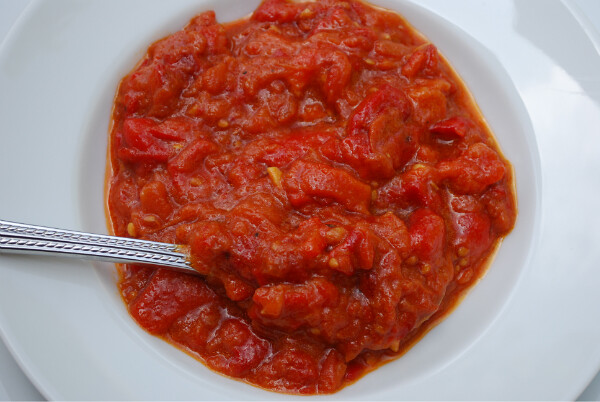Matbucha
Exploring the Vibrant Flavors of Matbucha: A Taste of Mediterranean Bliss
Introduction: In the colorful mosaic of Mediterranean cuisine, certain dishes stand out for their vibrant flavors, rich history, and cultural significance. One such culinary delight is Matbucha, a savory and aromatic tomato and pepper salad that hails from North Africa and the Middle East. With its bold colors, bold flavors, and versatile uses, Matbucha has captured the hearts and palates of food enthusiasts around the world. Join me on a flavorful journey as we uncover the origins, ingredients, preparation methods, and culinary heritage of this beloved Mediterranean dish.
Origins and Cultural Significance: Matbucha has its roots in the culinary traditions of North Africa, particularly Morocco and Algeria, where it is known as “Tamatem M’charmel” or “Salatet Bandora.” The dish has been enjoyed for centuries as a staple in the Mediterranean diet, offering a refreshing and flavorful accompaniment to meals. Over time, Matbucha has spread across the region, becoming a beloved dish in countries such as Israel, Tunisia, and Egypt, each adding its own unique twist to the recipe.
In addition to its culinary significance, Matbucha holds cultural and social importance, often served during festive occasions, family gatherings, and religious celebrations. It symbolizes hospitality, generosity, and the abundance of the land, reflecting the values and traditions of Mediterranean culture.
Ingredients: The beauty of Matbucha lies in its simplicity, with just a handful of fresh and wholesome ingredients coming together to create a dish that is greater than the sum of its parts. The key components typically include:
- Tomatoes: Ripe and juicy tomatoes serve as the base of the salad, providing a sweet and tangy flavor.
- Bell Peppers: Colorful bell peppers, such as red, green, and yellow, add sweetness, crunch, and vibrant hues to the dish.
- Garlic: Fresh garlic cloves are minced or finely chopped to add depth and aroma to the salad.
- Olive Oil: Extra virgin olive oil is used to sauté the vegetables and create a rich and silky texture.
- Spices: A blend of spices such as paprika, cumin, and chili flakes are added to the salad to enhance its flavor and add a hint of warmth.
- Salt and Pepper: A pinch of salt and freshly ground black pepper are added to taste, balancing out the flavors and bringing out the natural sweetness of the vegetables.
Preparation: The preparation of Matbucha is relatively simple, making it an ideal dish for both novice and experienced cooks alike. The general method involves the following steps:
- Sautéing the Vegetables: The tomatoes, bell peppers, and garlic are finely chopped or diced, then sautéed in olive oil over medium heat until softened and fragrant.
- Adding Spices: Once the vegetables are soft, the spices, salt, and pepper are added to the pan, allowing the flavors to meld together and the spices to bloom.
- Simmering: The mixture is then simmered over low heat until the tomatoes break down and the liquid reduces to create a thick and chunky sauce.
- Adjusting Seasoning: Taste the Matbucha and adjust the seasoning as needed, adding more salt, pepper, or spices to suit your preferences.
- Cooling and Serving: Once cooked, the Matbucha is allowed to cool to room temperature before serving, allowing the flavors to intensify and the salad to develop its full potential. It can be served as a side dish, appetizer, or condiment, alongside grilled meats, fish, or bread.
Variations and Regional Influences: While the basic recipe for Matbucha remains fairly consistent, there are variations and regional influences that can be found across the Mediterranean. In Morocco, for example, Matbucha may be flavored with preserved lemon or harissa paste for added complexity and heat. In Israel, chopped onions and hot peppers are often added to the salad, giving it a spicy kick. Some versions of Matbucha may also include additional vegetables such as eggplant, zucchini, or carrots, adding texture and flavor to the dish.
Health Benefits and Nutritional Value: Matbucha offers a range of health benefits, thanks to its nutrient-rich ingredients and minimal processing. Tomatoes are a good source of vitamins A and C, as well as antioxidants such as lycopene, which may help reduce the risk of chronic diseases such as heart disease and cancer. Bell peppers are rich in vitamin C, fiber, and antioxidants, while garlic has been shown to have antibacterial and immune-boosting properties. Olive oil provides heart-healthy fats and may help reduce inflammation and improve cholesterol levels when consumed as part of a balanced diet.
Conclusion: In a world filled with an abundance of culinary delights, Matbucha stands out as a shining example of Mediterranean cuisine at its finest. Its vibrant colors, bold flavors, and versatile uses make it a beloved dish that transcends borders and cultures. Whether enjoyed as a side dish, appetizer, or condiment, Matbucha invites us to savor the rich and diverse flavors of the Mediterranean, while celebrating the timeless traditions and cultural heritage of the region. As we take a bite of this savory and aromatic salad, we are reminded of the power of food to bring people together, bridge cultures, and create lasting memories.



